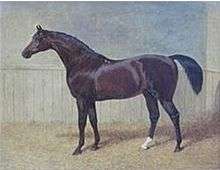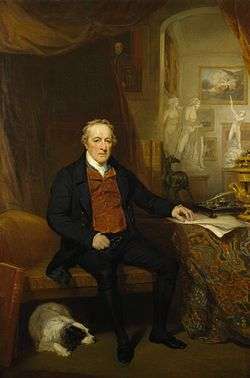Whalebone (horse)
Whalebone (1807 – 6 February 1831) was a British Thoroughbred racehorse that won the 1810 Epsom Derby and was a successful sire of racehorses and broodmares in the 1820s. Whalebone and his full-brother Whisker were produced by the prolific and important broodmare Penelope, and they contributed to the perpetuation of the genetic line (tail-male) of their sire Waxy and grandsire Eclipse into the 20th century. Whalebone raced until he was six years old and was retired to stud at Petworth in 1815. Whalebone sired the Derby winners Lap-dog, Spaniel and may have been the sire of Moses. Other notable sons are Sir Hercules and Camel, the sire of Touchstone. Whalebone died in 1831 at the age of 24 of hemorrhage after covering a mare.
| Whalebone | |
|---|---|
 Whalebone in a painting by John Frederick Herring, Sr., c. 1820 | |
| Sire | Waxy |
| Grandsire | Pot-8-Os |
| Dam | Penelope |
| Damsire | Trumpator |
| Sex | Stallion |
| Foaled | 1807 |
| Country | United Kingdom of Great Britain and Ireland |
| Colour | Bay |
| Breeder | Duke of Grafton |
| Owner | 1) 3rd Duke of Grafton 2) 4th Duke of Grafton 3) Mr. Ladbroke 4) Lord Egremont |
| Trainer | Robert Robson |
| Record | 20:14-2-3 |
| Major wins | |
| Epsom Derby (1810) | |
| Honours | |
| Leading sire in Great Britain and Ireland (1826 and 1827) | |
Background
Whalebone was bred by the Duke of Grafton in 1807 at his Euston Hall stud farm near Newmarket. He was sired by the 1793 Epsom Derby winner Waxy out of the mare Penelope (foaled in 1798), both owned by the Duke. As a racehorse, Penelope was a contemporary of the 1801 Derby-winning filly Eleanor, beating her several times, and was half-sister to 1809 Derby winner Pope and the mares Pope Joan (both sired by Waxy), Parasol (Partisan's dam) and Prudence.[1] Penelope was a prolific and influential broodmare, producing eight full-siblings to Whalebone that achieved success on the turf. She produced 13 foals between 1806 and 1823, all with names beginning with the letter W. Whalebone was her second foal and his full-siblings include Web, Woful, Wilful, Wire, Whisker, Wildfire and Windfall. Penelope died in 1824.[2]
Whalebone was a mottled bay or brown colt that stood 15.2 hands high[3] with "short legs, high-bred nostrils and very prominent eyes."[4] He was a "plainish looking"[3] horse with a "Turkish-pony look"[5] and thick neck and body that were not as well-proportioned as those of his full-brother Whisker. Whalebone was reportedly one of the smallest horses Waxy ever produced.[4] In the words of his groom, Dryman, "he was the lowest and longest, and most-double jointed horse, with the best legs—eight and a half below the knee—and worst feet I ever saw in my life."[5]
Racing career
1810: three-year-old season
Whalebone's first career start occurred on 9 May at Newmarket where Whalebone ran a dead heat and won the 50-guinea Newmarket Stakes, beating the colts Brother to Burleigh (Treasurer) and Eccleston while carrying 119 pounds.[6]
On 7 June at Epsom, Whalebone won the Derby Stakes, beating The Dandy, Eccleston and a field of eight other horses after leading from the start in a race where he "was never headed." He was the race favorite at 5 to 2, and his Derby win was a consecutive victory for the Duke of Grafton who had won the race the previous year with his colt Pope.[7] Pope was also sired by Waxy and was out of Whalebone's maternal grandam Prunella.[1]
At the First October Meeting at Newmarket, Whalebone received a forfeiture of 60 guineas from Mr. Shakespear's colt Nuncio[8] and walked over for a 25-guinea subscription stakes.[9] On 29 October at Houghton, Whalebone was beaten in a match race by the colt Treasurer while carrying seven more pounds than his opponent.[10] A few days later at the same meeting Whalebone secured two wins in match races, beating Major Wheatley's colt Sir Marrinel while carrying eight pounds more than his opponent[11] and beating the colt Thorn a day later.[12] He also received forfeitures of 100 guineas from Mr. Shakespear's Knave of Clubs[13] and an unspecified amount from G. H. Cavendish's colt Florival.[14]
1811: four-year-old season

In May, Whalebone received 60 guineas forfeiture from Mr. Henry Vansittart's colt Gloster.[15] On 6 August at Huntingdon, Whalebone was third in the Portholme Stakes to the filly Barrosa and the colt Bolter.[16]
For the Newmarket Trial Stakes on 30 September, Whalebone was third to the colt Florival and the filly Sprightly.[17] Whalebone won the 100-guinea King's Plate a few days later,[18] and at the Second October Meeting, received a forfeit from major Wilson's colt Erebus[19] and was unplaced for the Cheveley Stakes.[20] In November he received 140 guineas forfeit from Mr. Shakespear's colt Tumbler.[21]
1812–1813: five and six-year-old seasons
At the Newmarket-Craven Meeting, Whalebone was beaten in a match race by Major Wilson's colt Bolter.[22] In April at Newmarket, Whalebone won the 100-guinea King's Plate[23] and was third in a 300-guinea sweepstakes race to the colts Trophonius (not the 2000 Guineas winner) and Invalid.[24] In July at Newmarket, he won a £50 race[25] and paid a 10-guinea forfeit for a handicap sweepstakes.[26] On 9 September at Northampton, Whalebone won a 100-guinea gold cup race against four other horses.[27]
Whalebone was sold by the Duke of Grafton in October 1812 to Mr. Ladbroke for 700 guineas.[28] Whalebone's first start under Ladbroke's ownership was on 26 October at the Houghton meeting where he won a match race against Mr. Lake's two-year-old colt Turner.[29] Whalebone won an additional match race against the Lord Sackville's horse Pan at the same meeting.[30] Whalebone ran three times in 1813, winning the 100-guinea His Majesty's Plate on 8 June at Guildford against three other horses[31] and the Lewes His Majesty's Plate on 5 August.[32] On 7 August, in what was ultimately the last start of Whalebone's racing career, he won the 60-guinea Ladies' Plate against Lord Somerset's colt Offa's Dyke.[33]
Interim
Ladbroke reportedly "took a dislike to Whalebone"[4] and sold him in 1814 for 510 guineas to Lord Egremont.[34] Whalebone was initially thought to be a poor stud prospect due to his small stature and Lord Egremont put him back into training.[4] However, the seven-year-old horse had become "dangerous to ride," having "acquired the habit of rearing to an alarming extent"[28] and would frequently "knock his hooves together like a pair of castanettes."[4] Consequently, he was permanently retired from racing and became a breeding stallion for Lord Egremont in 1815.
Stud career
Whalebone began his stud career at Petworth in Sussex in 1815 for a fee of 10 guineas per mare and one guinea for the groom alongside the stallions Octavius and Canopus.[35] His fee was 20 guineas per mare in 1830, the year preceding his death, and he stood at Petworth for the entirety of his 16-year stud career.[36] Whalebone sired The Derby winners Lap-dog, Spaniel and may have been the sire of Moses. Other notable sons are Sir Hercules and Camel, the sire of Touchstone.[28]
In his later years, Whalebone developed chronic foot problems due to his poor hoof conformation. His groom, Dryman, commented on his condition, "His feet were so contracted and high on the heel, and became so Chinese boot-like and full of fever at last, that he never moved out of his box."[5]
Whalebone "broke a blood vessel" on 5 February 1831 while breeding the mare Ogress.[37] He died of this injury the following day on 6 February 1831. Ogress foaled a bay filly by Whalebone in 1832, later named Eleanor, the last foal sired by Whalebone.
Pedigree
| Sire Waxy (GB) Bay, 1790 |
Pot-8-Os 1773 |
Eclipse | Marske |
|---|---|---|---|
| Spilletta | |||
| Sportsmistress | Sportsman | ||
| Golden Locks | |||
| Maria 1777 |
Herod | Tartar | |
| Cypron | |||
| Lisette | Snap | ||
| Miss Windsor | |||
| Dam Penelope (GB) Bay, 1798 |
Trumpator 1782 |
Conductor | Matchem |
| Snap Mare | |||
| Brunette | Squirrel | ||
| Dove | |||
| Prunella 1788 |
Highflyer | Herod | |
| Rachel | |||
| Promise | Snap | ||
| Julia (Family 1-o) |
- Whalebone was inbred 3 X 4 to Herod and 4 X 4 to Snap, meaning Herod appears twice in the third and fourth generations and Snap appears twice in the fourth generation of his pedigree
References
- Weatherby (1834). "Prunella". The General Stud Book. 1: 466.
- Weatherby (1834). "Penelope". The General Stud Book. 1: 743–744.
- Chismon, William (1901). Stallion record: being a dictionary of stallions of the XIX century. Liverpool: C. & H. Ratcliffe. p. 266.
- Taunton, Thomas Henry (1887). Portraits of celebrated racehorses of the past and present, Volume 2. London: Sampson Low, Marston, Searle & Rivington. p. 61.
- Fife and Drum (1906). "Horse pedigrees". Natal Agriculture Journal. 9: 1053.
- Staff (April–September 1810). "New Market First Spring Meeting". Sporting Magazine. 36: 25.
- Staff (April–September 1810). "Epsom Meeting-Surrey". Sporting Magazine. 36: 42.
- Hunter, Robert J. (October 1810). "October 1810". Racing Calendar. 21: 174.
- Hunter, Robert J. (October 1810). "October 1810". Racing Calendar. 21: 176.
- Hunter, Robert J. (October 1810). "October 1810". Racing Calendar. 21: 198.
- Hunter, Robert J. (October 1810). "October 1810". Racing Calendar. 21: 201.
- Hunter, Robert J. (October 1810). "October 1810". Racing Calendar. 21: 202.
- Hunter, Robert J. (October 1810). "October 1810". Racing Calendar. 21: 203.
- Hunter, Robert J. (October 1810). "October 1810". Racing Calendar. 21: 205.
- Hunter, Robert (May 1811). "May 1811". Racing Calendar. 22: 95.
- Hunter, Robert (August 1811). "August 1811". Racing Calendar. 22: 103.
- Hunter, Robert (September 1811). "September 1811". Racing Calendar. 22: 167.
- Hunter, Robert (October 1811). "October 1811". Racing Calendar. 22: 170.
- Hunter, Robert (October 1811). "October 1811". Racing Calendar. 22: 182.
- Hunter, Robert (October 1811). "October 1811". Racing Calendar. 22: 196–197.
- Hunter, Robert (November 1811). "November 1811". Racing Calendar. 22: 200.
- Hunter, Robert (April 1812). "April 1812". Racing Calendar. 23: 8.
- Hunter, Robert (April 1812). "April 1812". Racing Calendar. 23: 18.
- Hunter, Robert (April 1812). "April 1812". Racing Calendar. 23: 20.
- Hunter, Robert (July 1812). "July 1812". Racing Calendar. 23: 73.
- Hunter, Robert (July 1812). "July 1812". Racing Calendar. 23: 74.
- Hunter, Robert (September 1812). "September 1812". Racing Calendar. 23: 74.
- Lawley, F. (November 1895). "Two London bankers". Baily's Magazine of Sports & Pastimes. 64: 326.
- Hunter, Robert (October 1812). "October 1812". Racing Calendar. 23: 166.
- Hunter, Robert (October 1812). "October 1812". Racing Calendar. 23: 169.
- Hunter, Robert (June 1813). "June 1813". Racing Calendar. 24: 41.
- Hunter, Robert (August 1813). "August 1813". Racing Calendar. 24: 92.
- Hunter, Robert (August 1813). "August 1813". Racing Calendar. 24: 93.
- Mortimer, Roger; Onslow, Richard; Willett, Peter (1978). Biographical Encyclopedia of British Flat Racing. Macdonald and Jane’s. ISBN 0-354-08536-0.
- Hunter, Robert J. (1815). "Advertisements of stallions". Racing Calendar: 434.
- Hunter, Robert J. (1830). "Advertisements of stallions". Racing Calendar: 588.
- Staff (May 1833). "Obituary of celebrated turf horses". American Turf Register and Sporting Magazine. 4 (9): 441–442.
- Staff. "Whalebone 5x Pedigree". Retrieved 13 January 2012.